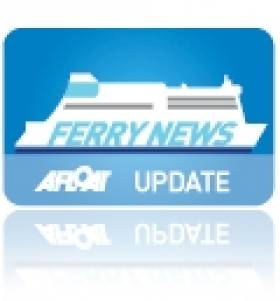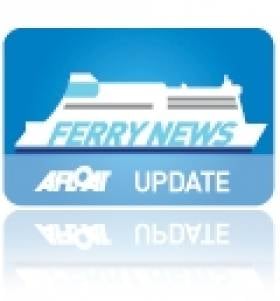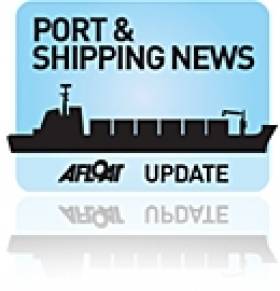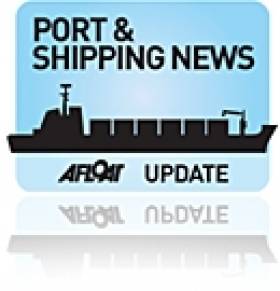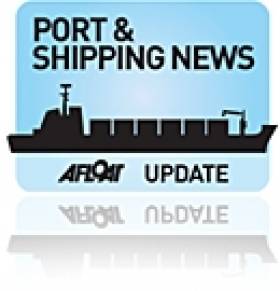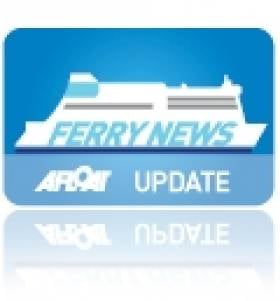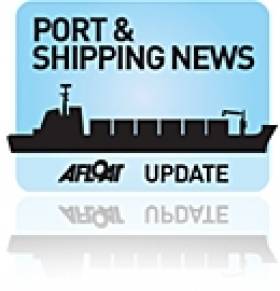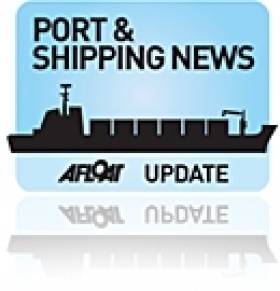Displaying items by tag: Ports & Shipping
Rising Costs Scuttle ICG's Ferry Profits
#FERRY NEWS – The Irish Continental Group (ICG) operators of ferry division Irish Ferries, said today its pre-tax profit for last year fell by 30 per cent to €28.2 million on the back of higher fuel costs, reports The Irish Times.
Despite the tough trading conditions, the group said it revenue for 2011 rose by 4.2 per cent to €273.3 million. Irish Ferries saw its passenger numbers for the year fall marginally by 0.7 per cent to 1,527 million, while its roll-on roll-off freight rose up by 9 per cent.
The company said the extremely challenging economic circumstances in the Republic contributed to the lack of growth in the market, and the pressure on operating costs for our freight customers remained intense.
Chairman John B McGuckian predicted the current year would remain challenging as fuel costs have further increased but with the group's "disciplined approach to capacity" he said he was confident of its prospects.
In the year to date, the ferry operator has carried 31,100 cars, down 8.5 per cent on 2011 and 138,600 passengers, up 0.8 per cent on 2011.
The reduction in car carryings partially reflects an 11 per cent reduction in sailings in the year to date but also a quieter than expected start to the year, it said.
Vessels Collide in Belfast Lough
#FERRY NEWS – A passenger ferry and cargo vessel collided in Belfast Lough last night and there are no reports of any injuries. The incident happened close to the Fairway buoy about a mile and a half from shore between Carrickfergus and Helen's Bay, according to BBC News.
It is understood that the ferry Stena Feronia (1997/21,856grt) has now docked at the Stena terminal. The other vessel - a cargo ship, the Union Moon (1985/1,543grt)- was accompanied by the coastguard as it was brought back to Belfast.
The ferry was on its way from Birkenhead, Merseyside, to Belfast when the collision happened, to read more on this story click HERE.
Newbuilds Expand Arklow Shipping Fleet
#NEWBUILDS-Two of the latest newbuilds for Arklow Shipping, one built in Spain and the second ship comleted from a South Korean shipyard, both entered service late last year and raises the fleet total to 44 vessels.
The northern Spanish built Arklow Forest became the 10th 'F' class vessel which was launched from Astilleros de Murueta SA. She is a 2,998grt vessel with a single-box hold with two portable bulkheads which can be placed into 10 positions for cargo separation. Her main engine plant is a MAN 6L27/38 2040kW gearbox with CPP, delivering about 12 knots.
Also entering service in late 2011 the Arklow Moor a 13,975dwt newbuild which formed the fifth in the series of 'M'-class vessels and she was built in South Korea by the Mokpo Shipyard Corporation. The class have four holds with a total grain capacity of 18,110 m3. They are fitted with a MaK 6M 43C main engine, 5,400kW, Jake reduction gearbox and Rolls Royce CPP which delivers about 14 knots.
Both newbuilds are registered in their owner's homeport and are Irish flagged. Of the 44-strong fleet, the majority of vessels (34) are managed by Arklow Shipping and the balance of vessels (11) are run by Arklow Shipping N.V.
More Bananas Head for Cork
#PORTS & SHIPPING – As previously reported on Afloat.ie Maersk Line's newly launched liner service that includes the return of the banana trade to the Port of Cork continues as another shipment is due from Central America /Caribbean ports with the arrival of Nedlloyd Adriana (photo) tomorrow, writes Jehan Ashmore.
Nedlloyd Adriana (2003/ 26,833grt) is a younger sister of Maersk Nolanville (2004/26,833grt) which previously docked at the Ringaskiddy Deepwater Berth as part of the services weekly call. Onboard the 2,500 (TEU) twenty equivalent unit capacity containerships, they include 800 (reefer points) i.e electrically plugged in refrigerated containers to store perishable products.
Noting the cargo deck arrangement is divided by the superstructure, which in vessel design terms is not unusual, but is not normally seen in Irish waters due to this larger sized containership. She is fitted with three deck-mounted cranes positioned forward of the bridge and a single-aft crane to cater for the smaller cargo-deck astern.
The vessel was built in South Korea by Hyundai Heavy Industries in Ulsan and was launched as Adriana Star. She was later renamed P&O Nedlloyd Adriana until dropping her operators prefix in 2004.
When the vessel has completed operations in Ringaskiddy, she heads to UK and continental ports to complete the liner service which is served in total by a pool of eight similar sized vessels.
The term 'liner' service refers to a dedicated regularly operated network of long-distance routes across oceans that connect ports between the continents.
The liner service is complemented by an onward internal network of short-seas routes known as 'feeder' services and use smaller containerships such as Vega Stockholm (photo) which calls to Dublin Port (see BBC The 'Box') as previously reported on Afloat.ie
As in the case of the Maersk Line liner service which brings bananas from source directly to Cork, there is no requirement to transfer such cargo by feeder vessel from another port in the UK or mainland Europe.
Cruise Caller Line-Up for Galway Harbour
#CRUISE LINERS- Galway Harbour can look forward to welcoming nine cruise calls to the mid-west port this year, with the first visitor being Arion which is scheduled to arrive in Galway Bay during late May, writes Jehan Ashmore.
Arion harks back to an era of the more classically designed ships with graceful sweeping lines. The 5,888 tonnes veteran vessel was launched in 1965 at Pula, in Croatia, as Istra and later in her career she underwent a major reconstruction in a Lisbon shipyard during 2000.
Cruise & Maritime Voyages (CMV) will be sending their Marco Polo, another classic veteran, in July as part of a 12 night 'Emerald Isle' discovery cruise departing Tilbury, with en-route calls to Cobh and Glengariff the previous day.
For a full listing of the cruise-calls schedule click HERE.
Arklow Vessel Sets Record Cargo for Drogheda Port
#PORTS & SHIPPING – Drogheda Port set a record tonnage cargo with the arrival of Arklow Bridge (2011/4,723grt) last week. The vessel operated by Arklow Shipping N.V. as previously reported on Afloat.ie had carried 7,125 tonnes of maize, the largest ever single cargo handled in the Co. Louth port, writes Jehan Ashmore.
Arklow Bridge is the second 'B' class vessel that was built last year and the Dutch-flagged vessel loaded the cargo of maize in the Polish city of Gdynia for Comex McKinnon. The company is a leading player in the importation and trading of feedstuffs for the animal feed sector in Ireland.
Stevedoring services were handled by Fast Terminals, a new company which is a joint venture between Drogheda Port Company and Fast Shipping of Antwerp. The company became operational last Septemberand increases the number of stevedoring operations in the port to four.
Drogheda Port is developing its agri-sector business so to transport feedstuffs for the animal feed sector in Ireland. The agri-food sector is worth €7.8bn and is proving resilient, despite the downturn and growth from this indigenous sector will be vital to the country's overall economic recovery.
According to Drogheda Port Company, planning permission was recently received for the development of a 5,400sq m bulk storage facility at the Tom Roes Point Terminal. The downriver facility is situated closer to the open sea compared to the towns quays on the banks of the Boyne.
Mr Paul Fleming, Drogheda Port Chief Executive said "Drogheda Port continues to provide a strategic import and export location for our customers with a service which is more flexible and cost competitive than other larger ports".
He added: "This is helping us to win new contracts and grow our business in addition to providing a platform to Ireland's importers and exporters to reach their markets more cost competitively."
Mr Simon Mulvany, Director of Fast Terminals said "Fast Terminals has identified the competitive opportunities that Drogheda Port can offer our company. Despite the current economic downturn we intend to invest in the port and develop our facilities to cater for further growth in the future."
Cork-Swansea Ferry Firm Must Secure €1m
#FERRY NEWS - The operators of the Celtic Sea ferry route between Cork-Swansea need to secure over €1m in investment today in order to save the company after being thrown a €300,000 funding lifeline by Cork's local authorities.
Cork City Council agreed last night to invest €100,000 in the Fastnet Line, bringing its total investment in the company to €365,000.
It followed a 90-minute behind closed doors presentation by Fastnet Line's acting chief executive officer, Pádraic O'Kane. He is due to meet Enterprise Ireland this morning to discuss further investment. He declined to discuss the amount involved, but it is understood to be in the region of €400,000.
Finance Wales will await the outcome of those talks before it agrees to pump up to €800,000 in to the firm. For more about this story in today's Examiner click HERE
Harland & Wolff Secure Dry-Docking Contract of Canadian FPSO
#PORTS & SHIPPING – Harland & Wolff Heavy Industries Ltd (H&W) have secured a contract to dry dock and service the Searose (2004/139,950dwt) a Canadian east coast based floating production storage and offloading (FPSO) vessel later this year.
The 272 metres long by 46 metre beamed FPSO is operated by Husky Oil and is based at the White Rose oilfield, 350km off the Newfoundland coast.
Searose will be dry-docked at H&W's Belfast Repair Dock and also use the Repair Quay during May and June. The work at the Queen's Island facility will be led by an integrated project team made up of owner and H&W personnel along with key contractors and vendors.
"H&W, along with our key contractors, are pleased to have secured the SeaRose FPSO project and to demonstrate the capabilities of the UK Oil & Gas supply chain," said H&W Project Manager James Lappin.
"This is an important opportunity, not only for H&W but for Northern Ireland, to extend a welcome to our Canadian visitors and demonstrate our world class facilities."
"We are proud that they have put their trust in us," H&W Chief Executive Officer Robert J Cooper said. "All levels of H&W are committed to ensuring this important project is completed safely and successfully."
H&W was founded over 150 years ago and has built some of the world's most famous ships, including three from the White Star Line: the Olympic, Titanic, and the Britannic, P&O's Canberra and the RN World War II battle-cruiser HMS Belfast, where she remains at moorings on the Thames.
Mainport to Invest in Survey Supply Vessels for Exploration Industry
#PORTS & SHIPPING - Cork based marine services company, Mainport is investing $36 million (€27.6 million) to build three supply vessels which will support seismic survey ships searching for oil and gas deposits.
The bulk of the financing for the construction of the newbuildings has been provided by Dutch bank ABN Amro, with a syndicate of Irish investors assembled by Westboro Finance in Cork providing $5 million in mezzanine, or short-term, financing.
The three ships, which will provide support services for an unnamed client carrying out off-shore seismic surveys around the world, are being constructed at Shin Yang Shipyards in Malaysia, and will be delivered in mid-2013.
To read more about this report in today's Irish Times click HERE
Seatruck Newbuild Making Progress On Irish Sea
#FERRY NEWS -Seatruck Ferries newbuild freight-only ferry, Seatruck Progress carried out berthing trials in Dublin Port yesterday in preparation to her debut on the Liverpool route over the festive period, writes Jehan Ashmore.
This was the inaugural call to the capital, though she had sailed across Dublin Bay earlier this month (as previously reported - click HERE) during her delivery voyage to Liverpool from German shipbuilders FGS Flensburger.
At 142 metres long and with a beam of 24 metres, the four decked ro-ro vessel, offers more capacity to the routes existing pair of 'Point' class vessels, as she can handle an extra 35 trailer units (each of 13.5m) than the Clipper Point and Clipper Pennant.
In February, the newcomer's second sister out of four on order, Seatruck Power is set to join her on the central corridor route.
Seatruck are the only Irish Sea operator dedicated to the carriage of un-accompanied freight traffic, though the vessels can cater for driver accompanied units with a limited number of cabins.



























